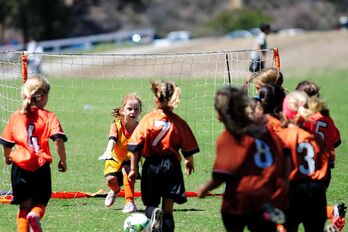7 Signs Your Kids Are Ready For Sports
You may think your kids are ready for organized sports, especially when so many of their peers are signing up. But many young kids don’t develop the physical, emotional, or mental skills it takes to compete until second or third grade.
Kids who start too soon may end up feeling frustrated or humiliated, or suffering physical injuries. Most experts agree that 6 is the youngest age to start playing organized sports, and many recommend waiting until your kids are 8. But kids develop at different times, so readiness depends more on their size, skill and maturity than on age.
To make sure you’re not jumping the gun, look for the following signs before considering sports for your kids. They will be ready for sports when they:
1. Show an interest in sports. There’s no reason to push your kids into team sports if they have no desire to play. In fact, forcing them can make them resent all organized sports. So if your kids aren’t ready yet, let them run around outside with their friends; it will give them the exercise they need until they find sports they’d like to try.
2. Are strong and skilled. If your kids are smaller and weaker than their peers, or if they can’t throw, bat or catch very well, they’ll be at a huge disadvantage. They’ll also be more likely to get injured. Before you send them onto the field to compete with kids who are naturally more able, spend another year practicing with them in the backyard so they can build their physical strength and skill.
3. Can understand and follow directions. Processing and acting on information from multiple sources -- coaches, parents, teammates and bossy siblings -- is a real challenge for many young kids. Most won’t have that ability until they are 6 or 7, at the earliest.
4. Focus on an activity for two hours. When you see young kids picking weeds or staring up at the clouds during practice, you know they don’t have the attention span to stick with an entire game. The ability to sustain focus comes with age, not experience, so it’s better to wait until your kids mature.
5. Get the concept of teamwork and taking turns. Playing organized sports means sharing the spotlight and giving everyone their turn at bat. Hogging the ball -- and everyone’s time and attention -- won’t make your kids very popular.
6. Get along with other kids. If your kids have trouble navigating social situations or working in a group at school, they’ll have an especially tough time with the dynamics and competitive nature of a team. Give them more time to build up those skills off the field.
7. Can handle losing without losing it. Winning is easy; losing can be devastating. If your kids tend to cry or get angry when they lose at sports or board games at home, they are probably not ready for a graceful defeat in public.
Organized sports are a great learning experience and an excellent way for kids to stay fit -- but they’re also supposed to be fun. Your kids will enjoy themselves more when they’re ready for it. Please visit the Presidential Fitness website for more information





